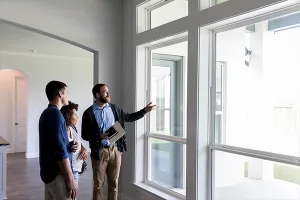Every month, NAR releases the Commercial Market Insights Report (CMI), which provides an in-depth analysis and market insights on the commercial real estate market, with a focus on multi-family, office, industrial, and retail properties. It has been especially important as a way to track developments in commercial real estate during the pandemic since the report's inception in June 2020.
Gay Cororaton, Senior Economist, Director of Housing and Commercial Research, and Brandon Hardin, Research Economist, are the lead authors of the report. In this conversational Q&A, they provide insights into the data, perspectives on how members can use the report, and the results they found to be most interesting.
What makes this report different from other Commercial reports that NAR has produced in the past?
Gay Cororaton: The CMI Report is so different in terms of content, depth of analysis, frequency, and relevance to our members. Since I joined NAR in 2012 and up until we produced the CMI, NAR had only published a quarterly market report, with data mainly from a survey of NAR commercial markets and without an in-depth analysis by asset class and geographic markets.
In contrast, the CMI report is released monthly, contains market trends on five property markets (multifamily, office, retail, industrial, and the hotel sector), and we are starting to introduce more metro level data in the report. For example, here are the latest trends we are tracking:
- As of February 2021, the commercial real estate market is recovering, but it is still weaker overall compared to one year ago. Sales transactions in the first quarter still 28% below year-ago levels. Commercial real estate prices continue to firm up, but the value of commercial real estate is still broadly down by 6% compared to one year ago.
- However, the pandemic has hit each sector differently, and the multifamily and industrial properties market have been the strongest legs during this pandemic year, while the hotel and office sectors have struggled the most.
- In the office market that I track more closely, the overall office vacancy rate has surged in the big cities, but vacancy rates have increased only modestly in secondary or tertiary markets. Vacancy rates are up sharply in San Francisco (+12.7 percentage points), Seattle (+9 percentage points), New York (+8.8 percentage points) and Austin (+8. 3 percentage points), mainly driven by the increase in space being subleased. However, office vacancy rates in smaller cities have increased only modestly, such as Tucson (+0.6 percentage points), Northern Virginia (+0.7 percentage points), and Long Island (+ 1 percentage points).
One other feature that's different in the CMI report from the quarterly commercial market report are the featured "insight pieces" that enable us to take a deeper dive on emerging trends across property classes such as ghost kitchens (June 2020 — the seminal issue of the CMI report), food delivery services (July 2020), adaptive reuse of retail for industrial space (October 2021), rising apartment rent trends in smaller cities as rents decline in big cities (November 2020), the shift in multifamily demand towards suburban areas (January 2021), and how a hybrid workstyle could impact the demand for flexible office space (February 2021).
Brandon Hardin: This report is different as it provides more in-depth analysis and market insights across CRE markets and current economic conditions. In this report we focus on office, industrial, retail, and multi-family properties. The CMI not only provides in-depth analysis but goes beyond surface-level analysis as it looks at specific key trends and insights that vary on a monthly basis. The monthly nature of this report is a divergence from other reports that are done on a quarterly or annual basis. This report provides our members with more macro-level information they want at a more frequent rate in comparison to some of our past and current reports. This report is all about staying on top of the markets and what has happened.
What questions is this report trying to answer? What gaps in data is this report trying to fill?
Gay Cororaton: As background, the CMI Report was a response to our commercial members' need for timely information on the COVID-19 pandemic's impact on the commercial real estate market across property levels and geographic areas. That need was clearly expressed at the May Legislative Meetings in 2020, specifically at the Commercial Real Estate Research Advisory Board meeting. So, we quickly responded to that urgent need for information by producing this report, which was released the next month, in June 2020.
In the CMI Report, we track activity indicators such as sales transactions, commercial prices, cap rates, and distress sales. We track the commercial market conditions of demand and supply by looking at absorption or changes in occupancy, vacancy rates, rents, leasing, and completion. Last, but not least, we track economic variables that affect the demand for commercial real estate such as employment, retail sales, consumer income and spending, and working from home trends. For example, we know that the number of people working from home has quadrupled from 6% in 2019 to 21% as of March and that, in the case of computer workers, 58% are still working from home. So, until this fraction returns to pre-pandemic levels, we expect office vacancy rates to remain elevated.
Brandon Hardin: The questions the report answers are where have we been, and where are we now. The report accomplishes this by looking at various sources of data to paint the overall CRE market landscape.
As a monthly report, have you seen any surprising changes in the data since the report's inception?
Gay Cororaton: One "surprise" I've seen is how office asking rents have not fallen, despite the surge in vacancy rates. In 2020 Q1, the average office asking rent was $ 33.69/sq. ft. In 2021 Q1, the average office asking rent rose to $35.40, even if during this time the office vacancy rate rose from 13% to 16.4%. However, according to a survey of our commercial members, 55% reported they are seeing landlords giving more concessions. So, I think what's happening is that landlords see that the pandemic is a temporary, short-term shock, so they are not lowering their asking rents but are effectively reducing the rent by offering concessions.
Related to this is how some markets have experienced a phenomenal increase in office asking rents in some markets. For example, office asking rents have grown 23% in Fort Myers/Naples, 20% in Roanoke, and 17% in Colorado Springs. So, something is driving demand in these markets. In Fort Myers, it's medical office space, and in Roanoke and Colorado Springs, it's demand in the booming industrial commercial real estate that's spilling into the demand for office space.
So, while the headline numbers are gloomy, there are pockets of growth and I get excited that we are able to share these wonderful insights with our members.
Brandon Hardin: Yes. There are a plethora of changes in the data since the report's inception. Considering the frequency of this report, we are able to see the essence of trends as we break down data at a more frequent rate. If we consider the current pandemic, this report has afforded us the opportunity to see how sectors are reacting to all of their influencing factors. This report allows us to see some of the more transient and permanent shocks and trends as we analyze the data more frequently. Considering the report began back in the early stages of the pandemic, we are able to see significant changes in the data. Have we seen any surprising changes: yes, we have. There were surprises around every corner as the report captured what is hopefully a one-time event (the coronavirus pandemic). The creation of this new report, during an unprecedented time, has yielded unprecedented results. So, it is all surprising in a sense that even though we saw CRE take a hit and especially certain sectors like hotels and retail, we saw how resilient the markets are with most recovering and some on a trajectory to recover.
What aspects of this report do you find most interesting?
Gay Cororaton: The aspects that I find most interesting are the insight pieces where we do a deeper dive into emerging trends. As a researcher, these insight pieces give me the opportunity to go deeper than the ‘headline' numbers. For example, in February, I did an insights piece on how a hybrid work style could impact the demand for flexible office space. I learned a bit more about the flexible office space market, starting off with what "flexible space" or "co-working" even meant and getting a better understanding of the flexible space market. I learned that flexible space is called such because the leases are short term (as short as a month) and the lease can be as tiny as one desk or an entire floor or floors for institutional occupiers. I learned that flexible space operators have established market niches along the flexible space continuum. So, companies like WeWork essentially cater to those who are "co-working" where a worker works in an open space area that is either a "hot" seat or dedicated seat. On the other hand, a company like Regus, for example, mainly serves institutional occupiers who lease dedicated offices or entire floors. Flexible space leasing grew by leaps and bounds before the pandemic, though it made up just about 3% of total office inventory. However, tech users are the main clients, so it's not a surprise that when workers worked from home during this pandemic, it's the New York, San Francisco, Seattle, Austin, and Nashville markets that saw huge spikes in vacancy rates.
Brandon Hardin: While I find all of the aspects of the report fascinating, I really find the deep-dive insights particularly interesting. This is the portion of the report where were look deep into the data to uncover the treasures of CRE. I find this, in particular, to be really interesting as when you dig deep into the data, you divulge the hidden forces of trends and can really understand the who, what, when, where and why of certain CRE topics and fundamentals. This is also interesting to me because we don't always stick to the fundamentals of CRE in the insights portion. But we peel back, like layers of an onion, what are some of the influencing trends in CRE our members should be cognizant of.
How can our members use this data?
Gay Cororaton: Members can use the data to understand overall market trends or use the data to inform their transactions. One example of this is cap rates. Falling cap rates mean that commercial prices or valuations are firming up. Cap rates are also a starting point for evaluating if the price on a property is overvalued or undervalued. In February, the risk spread for the office acquisitions was 5.4% (5.1% one year ago). So, if one is acquiring an office property with a 5.5% risk spread it could mean the property is overpriced, or it could be priced fairly due to less risky cash flow, but in either case, the risk spread that members can find in the report serves as a starting point for a property's valuation.
Brandon Hardin: Our members can use this data to structure approaches to how real estate is developed, valued, acquired, and purchased. This data alongside our fantastic members is invaluable as it provides them with supplementary means to serve their clients better and more efficiently.








